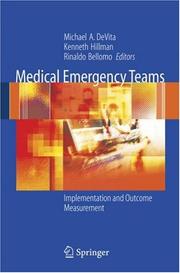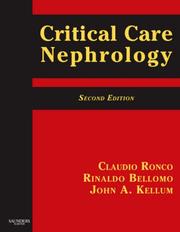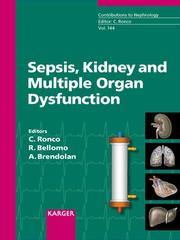| Listing 1 - 10 of 13 | << page >> |
Sort by
|

ISBN: 1280945060 9786610945061 0387279210 0387279202 Year: 2006 Publisher: New York, NY : Springer,
Abstract | Keywords | Export | Availability | Bookmark
 Loading...
Loading...Choose an application
- Reference Manager
- EndNote
- RefWorks (Direct export to RefWorks)
Why Critical Care Evolved METs? In early 2004, when Dr. Michael DeVita informed me that he was cons- ering a textbook on the new concept of Medical Emergency Teams (METs), I was surprised. At Presbyterian-University Hospital in Pittsburgh we int- duced this idea some 15 years ago, but did not think it was revolutionary enough to publish. This, even though, our fellows in critical care medicine training were all involved and informed about the importance of “C- dition C (Crisis),” as it was called to distinguish it from “Condition A (Arrest). ”We thought it absurd to intervene only after cardiac arrest had occurred,because most cases showed prior deterioration and cardiac arrest could be prevented with rapid team work to correct precluding problems. The above thoughts were logical in Pittsburgh, where the legendary Dr. Peter Safar had been working since the late 1950s on improving current resuscitation techniques, ?rst ventilation victims of apneic from drowning, treatment of smoke inhalation, and so on. This was followed by external cardiac compression upon demonstration of its ef?ciency in cases of unexpected sudden cardiac arrest. Dr. Safar devoted his entire professional life to improvement of cardiopulmonary resuscitation. He and many others emphasized the importance of getting the CPR team to o- of-hospital victims of cardiac arrest as quickly as possible.
Hospitals --- Health care teams. --- Medical emergencies. --- Cardiac arrest --- Emergency services. --- Prevention. --- Arrest, Cardiac --- Cardiopulmonary arrest --- Heart arrest --- Sudden cardiac death --- Heart --- Heart failure --- Emergencies --- Emergency medicine --- First aid in illness and injury --- Health teams --- Medical care teams --- Patient care teams --- Team work in medicine --- Teamwork in medicine --- Medical cooperation --- Medical personnel --- Emergency rooms --- Emergency services in hospitals --- Hospital emergency services --- Emergency medical services --- Diseases --- Emergency service --- Critical care medicine. --- Emergency medicine. --- Anesthesiology. --- Intensive / Critical Care Medicine. --- Emergency Services. --- Emergency Medicine. --- Anaesthesiology --- Surgery --- Medicine, Emergency --- Medicine --- Critical care medicine --- Disaster medicine --- Medical emergencies --- Intensive care --- Intensive medicine --- Intensive care units
Book
ISBN: 0387928529 9786613086792 0387928537 1283086794 Year: 2010 Publisher: New York : Springer,
Abstract | Keywords | Export | Availability | Bookmark
 Loading...
Loading...Choose an application
- Reference Manager
- EndNote
- RefWorks (Direct export to RefWorks)
Textbook of Rapid Response Systems is designed to assist the medical practitioner or administrator to implement and improve a Rapid Response System, from the logistics of creating a Rapid Response System (including resource allocation, process design, workflow, and training), to the problem of patient safety and quality of care, the evaluation of program results, and engagement in systems research. Written by the world’s leading innovators in the development of Rapid Response Systems, this brand new book takes the place of its groundbreaking predecessor, DeVita, Hillman, and Bellomo, eds., Medical Emergency Teams (Springer, 2006) and includes coverage of pediatric response systems and sepsis response teams, as well as advice, tips, and process guidelines from successful Rapid Response Systems. Textbook of Rapid Response Systems is an invaluable resource for healthcare professionals seeking to improve quality of care in the emergency setting.
Health facilities -- Safety measures. --- Hospitals -- Safety measures. --- Hospitals --- Health care teams --- Medical emergencies --- Cardiac arrest --- Health Services Administration --- Hospital Departments --- Emergency Medical Services --- Patient Care Team --- Health Services --- Health Care --- Hospital Administration --- Health Facilities --- Health Care Facilities, Manpower, and Services --- Emergency Service, Hospital --- Hospital Rapid Response Team --- Patient Care Management --- Organization and Administration --- Organizational Innovation --- Public Health --- Medicine --- Health & Biological Sciences --- Hospitals & Medical Centers --- Emergency Medicine --- Emergency services --- Prevention --- Emergency medical services. --- Health care teams. --- Health services administration. --- Medical care --- Patient safety. --- Health administration --- Health care administration --- Health care management --- Health sciences administration --- Health services management --- Benevolent institutions --- Infirmaries --- Health teams --- Medical care teams --- Patient care teams --- Team work in medicine --- Teamwork in medicine --- Emergency health services --- Emergency medical care --- Emergency rooms --- Emergency services in hospitals --- Hospital emergency services --- Emergency services. --- Administration. --- Quality control. --- Evaluation. --- Administration --- Management --- Emergency service --- Medicine. --- Anesthesiology. --- Emergency medicine. --- Critical care medicine. --- Cardiology. --- Medicine & Public Health. --- Intensive / Critical Care Medicine. --- Emergency Medicine. --- Health planning --- Public health administration --- Health facilities --- Medical cooperation --- Medical personnel --- Emergency medicine --- Rescue work --- Emergency medical services --- Anaesthesiology --- Surgery --- Medicine, Emergency --- Critical care medicine --- Disaster medicine --- Intensive care --- Intensive medicine --- Intensive care units --- Heart --- Internal medicine --- Diseases
Book
ISBN: 0199352852 1282543571 9786612543579 0199748543 9780199748549 9780195392784 0195392787 9780199352852 9781282543577 6612543574 0199889384 Year: 2010 Publisher: Oxford ; New York : Oxford University Press,
Abstract | Keywords | Export | Availability | Bookmark
 Loading...
Loading...Choose an application
- Reference Manager
- EndNote
- RefWorks (Direct export to RefWorks)
In the past decade, CRRT has moved from a niche therapy within specific specialty centers to the standard of care for management of critically ill patients with acute renal failure. Continuous Renal Replacement Therapy provides concise, evidence-based, to-the-point bedside guidance about this treatment modality, offering quick reference answers to clinicians' questions about treatments and situations encountered in daily practice. Organized into sections on Theory; Pratice; Special Situations; and Organizational Issues, Continuous Renal Replacement Therapy provides a complete view of CRRT theo
Acute renal failure --- Continuous arteriovenous hemofiltration. --- Arteriovenous hemofiltration, Continuous --- CAVH (Medicine) --- Continuous arteriovenous hemodialysis --- Hemodialysis, Continuous arteriovenous --- Hemofiltration, Continuous arteriovenous --- Blood --- Acute kidney failure --- Acute renal insufficiency --- Kidney failure, Acute --- Renal failure, Acute --- Renal insufficiency, Acute --- Kidneys --- Treatment. --- Filtration --- Diseases

ISBN: 9781437711110 1437711111 9781416042525 1416042520 Year: 2009 Publisher: Philadelphia Saunders/Elsevier
Abstract | Keywords | Export | Availability | Bookmark
 Loading...
Loading...Choose an application
- Reference Manager
- EndNote
- RefWorks (Direct export to RefWorks)
Because of the increase in serious kidney diseases, including end-stage renal disease, your role as a nephrologist, intensivist, surgeon, or critical care physician is quickly expanding. Well received in its 1st edition, this 2nd edition continues to provide comprehensive coverage of the latest advances in critical care procedures for the adult or pediatric patient with renal diseases or disorders. Presents a common language and standardized guidelines to help multi-disciplinary physicians caring for the critically ill communicate more effectively. A new US editor, detailed discussions of diff
Book
ISBN: 0190225556 0190225564 0190225548 9780190225544 9780190225568 9780190225537 019022553X Year: 2016 Publisher: New York, New York : Oxford University Press,
Abstract | Keywords | Export | Availability | Bookmark
 Loading...
Loading...Choose an application
- Reference Manager
- EndNote
- RefWorks (Direct export to RefWorks)
This work provides concise, evidence-based, to-the-point bedside guidance about continuous renal replacement therapy, offering quick reference answers to clinicians' questions about treatments and situations encountered in daily practice.
Acute renal failure --- Continuous arteriovenous hemofiltration. --- Treatment. --- Acute Kidney Injury --- Hemodialysis Solutions. --- Kidney --- Renal Replacement Therapy --- therapy. --- injuries. --- methods.
Book
ISBN: 3318063061 331806307X Year: 2018 Publisher: S. Karger AG
Abstract | Keywords | Export | Availability | Bookmark
 Loading...
Loading...Choose an application
- Reference Manager
- EndNote
- RefWorks (Direct export to RefWorks)
Digital
Year: 2019 Publisher: Philadelphia, PA Elsevier, Inc
Abstract | Keywords | Export | Availability | Bookmark
 Loading...
Loading...Choose an application
- Reference Manager
- EndNote
- RefWorks (Direct export to RefWorks)
"Comprehensive and clinically relevant, the 3rd Edition of Critical Care Nephrology provides authoritative coverage of the latest advances in critical care procedures for patients with renal diseases or disorders. Using common guidelines and standardized approaches to critically ill patients, this multidisciplinary reference facilitates better communication among all physicians who care for critically ill patients suffering from kidney disease, electrolyte and metabolic imbalances, poisoning, severe sepsis, major organ dysfunction, and other pathological events"--Publisher's description.
Book
ISBN: 3805594720 3805594739 Year: 2010 Publisher: S. Karger
Abstract | Keywords | Export | Availability | Bookmark
 Loading...
Loading...Choose an application
- Reference Manager
- EndNote
- RefWorks (Direct export to RefWorks)
Book
ISBN: 9780323759298 Year: 2024 Publisher: Amsterdam, The Netherlands Elsevier
Abstract | Keywords | Export | Availability | Bookmark
 Loading...
Loading...Choose an application
- Reference Manager
- EndNote
- RefWorks (Direct export to RefWorks)
"Bridging the gap between medical and surgical specialties in critical care, Textbook of Critical Care, 8th Edition, offers a practical, multidisciplinary approach to the effective management of adult and pediatric patients in the ICU. An outstanding editorial team, led by world-renowned intensivist Dr. Jean-Louis Vincent, assisted by Dr. Frederick A. Moore and new editors Drs. Rinaldo Bellomo and John J. Marini, provides the evidence-based guidance you need to overcome a full range of practice challenges. A full-color art program, relevant basic science and key summary points in every chapter, and expert contributing authors from all over the world make this an indispensable resource for every member of the critical care team."--Provided by publisher.
Critical Care --- Intensive Care Units --- Critical care medicine --- Textbooks.

ISBN: 3805577559 9783805577557 1417564881 3318010898 Year: 2004 Publisher: S. Karger
Abstract | Keywords | Export | Availability | Bookmark
 Loading...
Loading...Choose an application
- Reference Manager
- EndNote
- RefWorks (Direct export to RefWorks)
Acute renal failure --- Kidney Failure, Acute --- Multiple Organ Failure --- Multiple organ failure --- Renal Replacement Therapy --- Renal intensive care --- Sepsis --- Septicemia --- Prevention --- Prevention & control --- Prevention & control --- Prevention --- Methods --- Etiology --- Prevention
| Listing 1 - 10 of 13 | << page >> |
Sort by
|

 Search
Search Feedback
Feedback About UniCat
About UniCat  Help
Help News
News